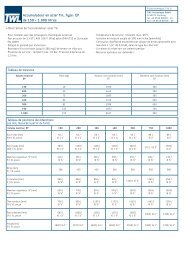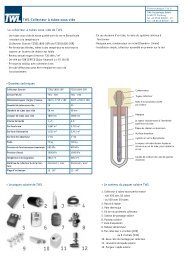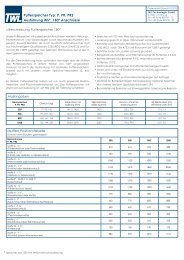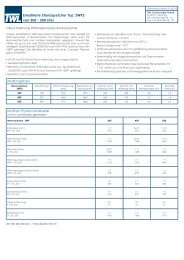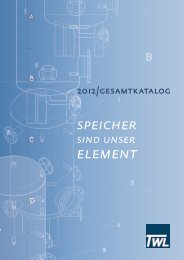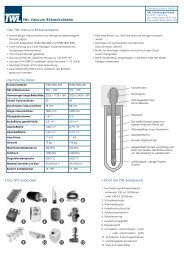SAFETY DATA SHEET - TWL-Technologie GmbH
SAFETY DATA SHEET - TWL-Technologie GmbH
SAFETY DATA SHEET - TWL-Technologie GmbH
Create successful ePaper yourself
Turn your PDF publications into a flip-book with our unique Google optimized e-Paper software.
<strong>SAFETY</strong> <strong>DATA</strong> <strong>SHEET</strong><br />
according to Regulation (EC) No. 1907/2006<br />
MS1508EC PE RTU GC HWT MS1508EC 500KG BB<br />
Product specification 13155 Revision Date 31.01.2013<br />
Version 1.0 Print Date 31.01.2013<br />
Material number 1387733 Page Page 5 of 12<br />
Components<br />
CAS-No.<br />
quartz (SiO2) 14808-60-<br />
7<br />
Further<br />
information:<br />
Value Control Expressed Update<br />
Basis<br />
type parameters as<br />
TWA 0,1 mg/m3 2007-08-01 GB EH40<br />
For the purposes of these limits, respirable dust and inhalable dust are those fractions of the<br />
airborne dust which will be collected when sampling is undertaken in accordance with the methods<br />
described in MDHS14/3 General methods for sampling and gravimetric analysis of respirable and<br />
inhalable dust, as amended by the ISO/CEN convention.<br />
The COSHH definition of a substance hazardous to health includes dust of any kind when present<br />
at a concentration in air equal to or greater than 10 mg/m3 8-hour TWA of inhalable dust or 4<br />
mg/m3 8-hour TWA of respirable dust. This means that any dust will be subject to COSHH if<br />
people are exposed above these levels. Advice on control is given in EH44 and in the great<br />
majority of workplaces reasonable control measures will normally keep exposure below these<br />
levels. However some dusts have been assigned specific WELs and exposure to these must<br />
comply with the appropriate limit.<br />
Most of industrial dusts contain particles of a wide range of sizes. The behaviour, deposition and<br />
fate of any particular particle after entry into the human respiratory system and the body response<br />
that it elicits, depend on the nature and size of the particle. HSE distinguishes two size fractions for<br />
limit-setting purposes termed 'inhalable' and 'respirable'.<br />
Inhalable dust approximates to the fraction of airborne material that enters the nose and mouth<br />
during breathing and is therefore available for deposition in the respiratory tract. Respirable dust<br />
approximates to the fraction that penetrates to the gas exchange region of the lung. Fuller<br />
definitions and explanatory material are given in MDHS 14/3.<br />
Where dusts contain components that have their own assigned workplace exposure limits, all the<br />
relevant limits should be complied with.<br />
Where no specific short-term exposure limit is listed, a figure three times the long-term exposure<br />
should be used<br />
HSC/E plans to review the limit values for this substance.<br />
TWA 6 mg/m3 2005-04-06 GB EH40<br />
Further<br />
information:<br />
For the purposes of these limits, respirable dust and inhalable dust are those fractions of the<br />
airborne dust which will be collected when sampling is undertaken in accordance with the methods<br />
described in MDHS14/3 General methods for sampling and gravimetric analysis of respirable and<br />
inhalable dust, as amended by the ISO/CEN convention.<br />
The COSHH definition of a substance hazardous to health includes dust of any kind when present<br />
at a concentration in air equal to or greater than 10 mg/m3 8-hour TWA of inhalable dust or 4<br />
mg/m3 8-hour TWA of respirable dust. This means that any dust will be subject to COSHH if<br />
people are exposed above these levels. Advice on control is given in EH44 and in the great<br />
majority of workplaces reasonable control measures will normally keep exposure below these<br />
levels. However some dusts have been assigned specific WELs and exposure to these must<br />
comply with the appropriate limit.<br />
Most of industrial dusts contain particles of a wide range of sizes. The behaviour, deposition and<br />
fate of any particular particle after entry into the human respiratory system and the body response<br />
that it elicits, depend on the nature and size of the particle. HSE distinguishes two size fractions for<br />
limit-setting purposes termed 'inhalable' and 'respirable'.<br />
Inhalable dust approximates to the fraction of airborne material that enters the nose and mouth<br />
during breathing and is therefore available for deposition in the respiratory tract. Respirable dust<br />
approximates to the fraction that penetrates to the gas exchange region of the lung. Fuller<br />
definitions and explanatory material are given in MDHS 14/3.<br />
Where dusts contain components that have their own assigned workplace exposure limits, all the<br />
relevant limits should be complied with.<br />
Where no specific short-term exposure limit is listed, a figure three times the long-term exposure<br />
should be used<br />
TWA 2,4 mg/m3 2005-04-06 GB EH40<br />
Further<br />
information:<br />
For the purposes of these limits, respirable dust and inhalable dust are those fractions of the<br />
airborne dust which will be collected when sampling is undertaken in accordance with the methods



